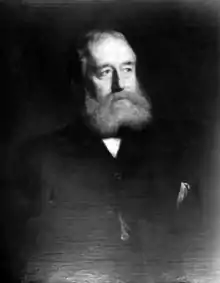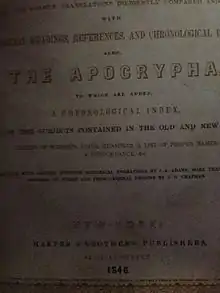Harper (publisher)
Harper is an American publishing house, currently the flagship imprint of global publisher HarperCollins based in New York City.
.jpg.webp) Group portrait of the four Harper brothers by Mathew Brady, c. 1860. Left to right: Fletcher, James, John, and Joseph | |
| Parent company | HarperCollins |
|---|---|
| Founded | March 6, 1817 (as J. & J. Harper) |
| Founder | James Harper John Harper |
| Headquarters location | New York City |
| Owner(s) | News Corp |
History
J. & J. Harper (1817–1833)

James Harper and his brother John, printers by training, started their book publishing business J. & J. Harper in New York City in 1817. Their two brothers, Joseph Wesley Harper and Fletcher Harper, joined them in the mid-1820s.
Harper & Brothers (1833–1962)
The company changed its name to "Harper & Brothers" in 1833. The headquarters of the publishing house were located at 331 Pearl Street, facing Franklin Square in Lower Manhattan (about where the Manhattan approach to the Brooklyn Bridge lies today).
Harper & Brothers began publishing Harper's New Monthly Magazine in New York City in 1850. The brothers also published Harper's Weekly (starting in New York City in June 1857), Harper's Bazar (starting in New York City in November 2, 1867), and Harper's Young People (starting in New York City in 1879).
George B. M. Harvey became president of Harper's on Nov. 16, 1899.[1]
Harper's New Monthly Magazine ultimately became Harper's Magazine, which is now published by the Harper's Magazine Foundation. Harper's Weekly was absorbed by The Independent (New York; later Boston) in 1916, which in turn merged with The Outlook in 1928. Harper's Bazar was sold to William Randolph Hearst in 1913, became Harper's Bazaar, and is now simply Bazaar, published by the Hearst Corporation.
In 1924, Cass Canfield joined Harper & Brothers and held a variety of executive positions until his death in 1986.[2] In 1925, Eugene F. Saxton joined the company as an editor, and he was responsible for publishing many well-known authors, including Edna St. Vincent Millay and Thornton Wilder.[3] In 1935, Edward Aswell moved to Harper & Brothers as an assistant editor of general books and eventually became editor-in-chief. Aswell persuaded Thomas Wolfe to leave Scribner's, and, after Wolfe's death, edited the posthumous novels The Web and the Rock, You Can't Go Home Again, and The Hills Beyond.[4]
Harper & Row (1962–1990)

In 1962 Harper & Brothers merged with Row, Peterson & Company to become Harper & Row. Harper's religion publishing moved to San Francisco and became Harper San Francisco (now HarperOne) in 1977. Harper & Row acquired Thomas Y. Crowell Co. and J. B. Lippincott & Co. in the 1970s; Crowell and the trade operations of Lippincott were merged into Harper & Row in 1980.[5] Marshall Pickering was bought by Harper & Row in 1988. Also in 1988, Harper & Row purchased the religious publisher Zondervan.[6]
HarperCollins (1990–present)
Rupert Murdoch's News Corporation (now News Corp) acquired Harper & Row in 1987, and William Collins, Sons in 1990. The names of these two national publishing houses (Harper & Row in the United States and Collins in the United Kingdom) were combined (along with the Harper's torch icon and Collins' fountain icon) to create HarperCollins.[7] The company has since expanded its international reach with further acquisitions of formerly independent publishers. The Harper imprint began being used in place of HarperCollins in 2007.
Paperbacks
After the purchase of Harper & Row by News Corporation, HarperCollins launched a new mass market paperback line to complement its existing trade paperback Perennial imprint. It was known as Harper Paperbacks from 1990 to 2000, HarperTorch from 2000 to 2006, and Harper from 2007 to the present.
Authors and illustrators (selected)
See also
References
- "HARPER & BROS. REORGANIZE.; G.B.M. Harvey, Editor and Proprietor of The North American Review, Elected President of the Firm". The New York Times. 17 November 1899. Retrieved 26 August 2016.
- "CASS CANFIELD, A TITAN OF PUBLISHING, IS DEAD AT 88". The New York Times. 28 March 1986. Retrieved 26 August 2016.
- "The New York Times: Sunday June 27, 1943". The New York Times. Retrieved 26 August 2016.
- "The New York Times: Thursday November 6, 1958". The New York Times. Retrieved 26 August 2016.
- Mitgang, Herbert (1980-03-27). "Harper Absorbs Lippincott & Crowell". Select.nytimes.com. Retrieved 2013-04-28.
- McDowell, Edwin (1988-07-14). "Harper & Row to Acquire Religious Books Publisher". The New York Times. ISSN 0362-4331. Retrieved 2018-01-20.
- Cohen, Roger (1990-06-11). "Birth of a Global Book Giant". The New York Times. ISSN 0362-4331. Retrieved 2019-11-26.
- "Harper Lee, Author of 'To Kill a Mockingbird,' Is to Publish a Second Novel". The New York Times. 4 February 2015. Retrieved 26 August 2016.
- "Men Who Make Pictures". The Weekly Wisconsin. 26 August 1885. p. 6 – via Newspapers.com.
Howard Pyle works almost exclusively for the Harpers.
- Charles Dudley Warner at the Encyclopædia Britannica
Further reading
- Jacob Abbott (1855), The Harper Establishment, New York: Harper & Brothers, OCLC 6798043, OL 14010983M
- Barnes, James J. "Edward Lytton Bulwer and the Publishing Firm of Harper & Brothers". American Literature (1966): 35–48. in JSTOR
- D'Amato, Martina. "'The Harper Establishment'; or, How a New York Publishing Giant Was Made".
- Exman, Eugene. The brothers Harper: a unique publishing partnership and its impact upon the cultural life of America from 1817 to 1853 (Harper & Row, 1965)
- Eugene Exman (1967), The House of Harper, New York: Harper & Row, OCLC 586430, OL 25416327M
- J. Henry Harper (1912), The House of Harper: a century of publishing in Franklin Square, New York: Harper, OL 7136715M
- Mellman, John A. (2017), "The Harper Torchbooks Series: A History and Personal Assessment", publishinghistory.com.
External links
| Wikimedia Commons has media related to Harper & Brothers. |
- Official website (US)
- Official website (UK)
- The Harper Brothers Founders of Harper Brothers Publishing
- Finding aid to Harper & Brothers records and Harper & Row Publishers records at Columbia University. Rare Book & Manuscript Library.